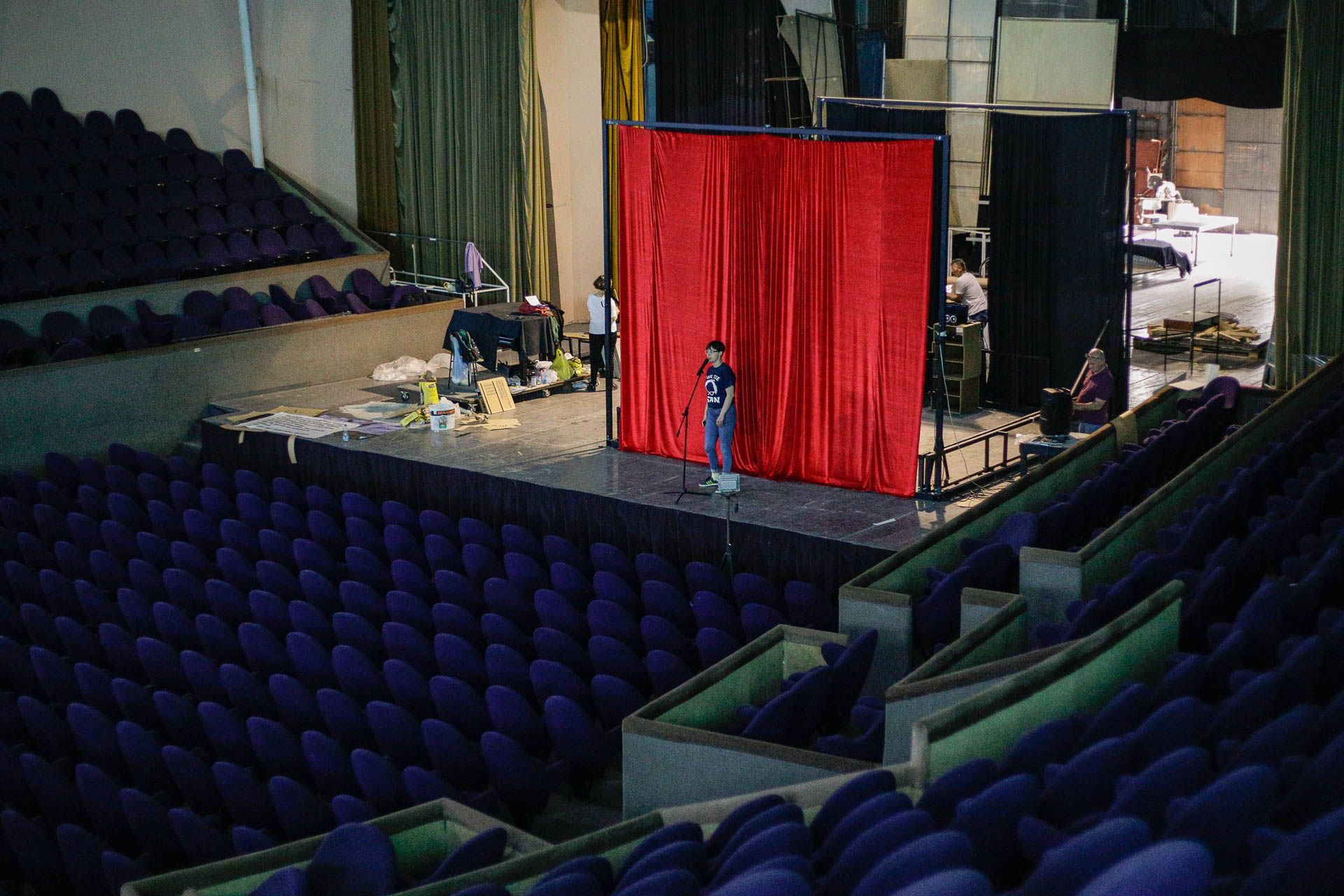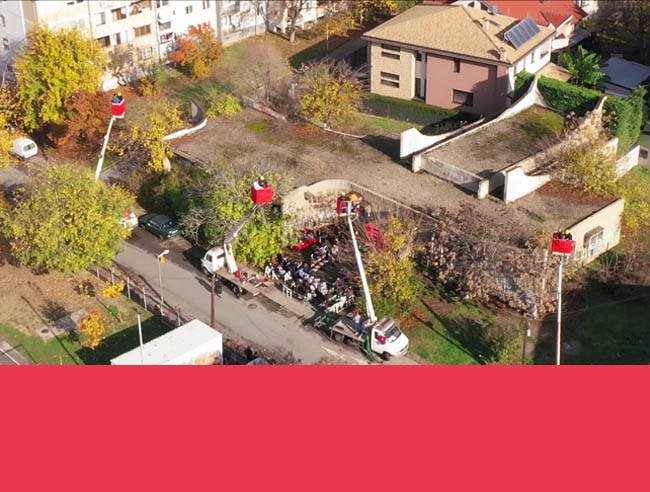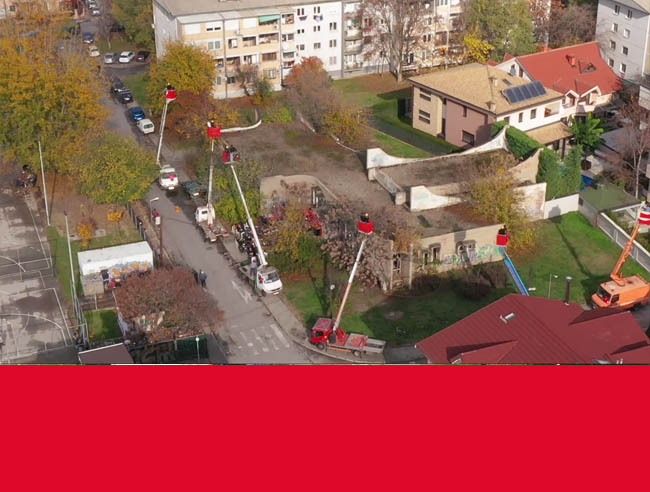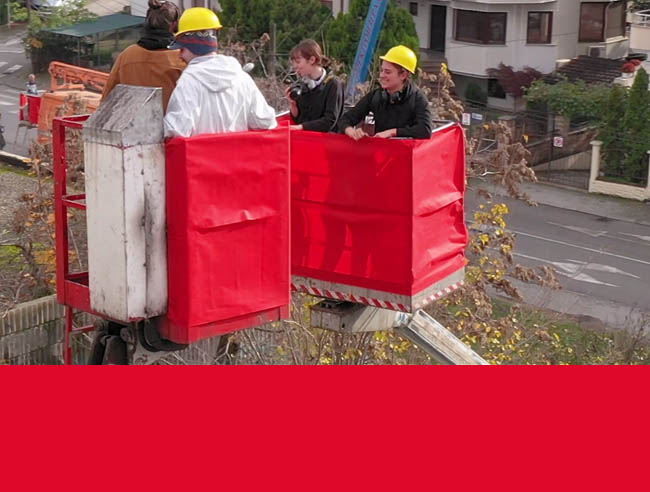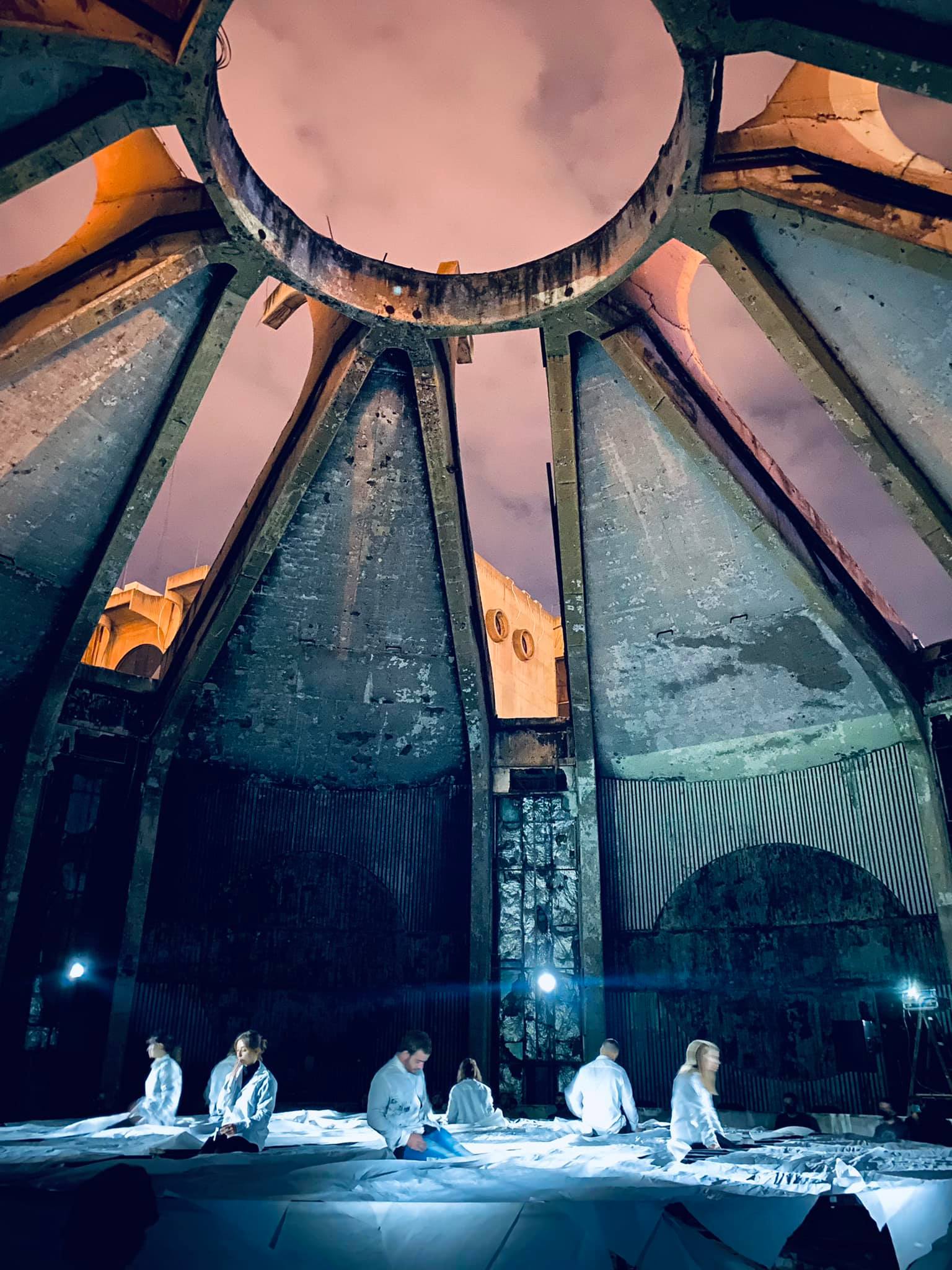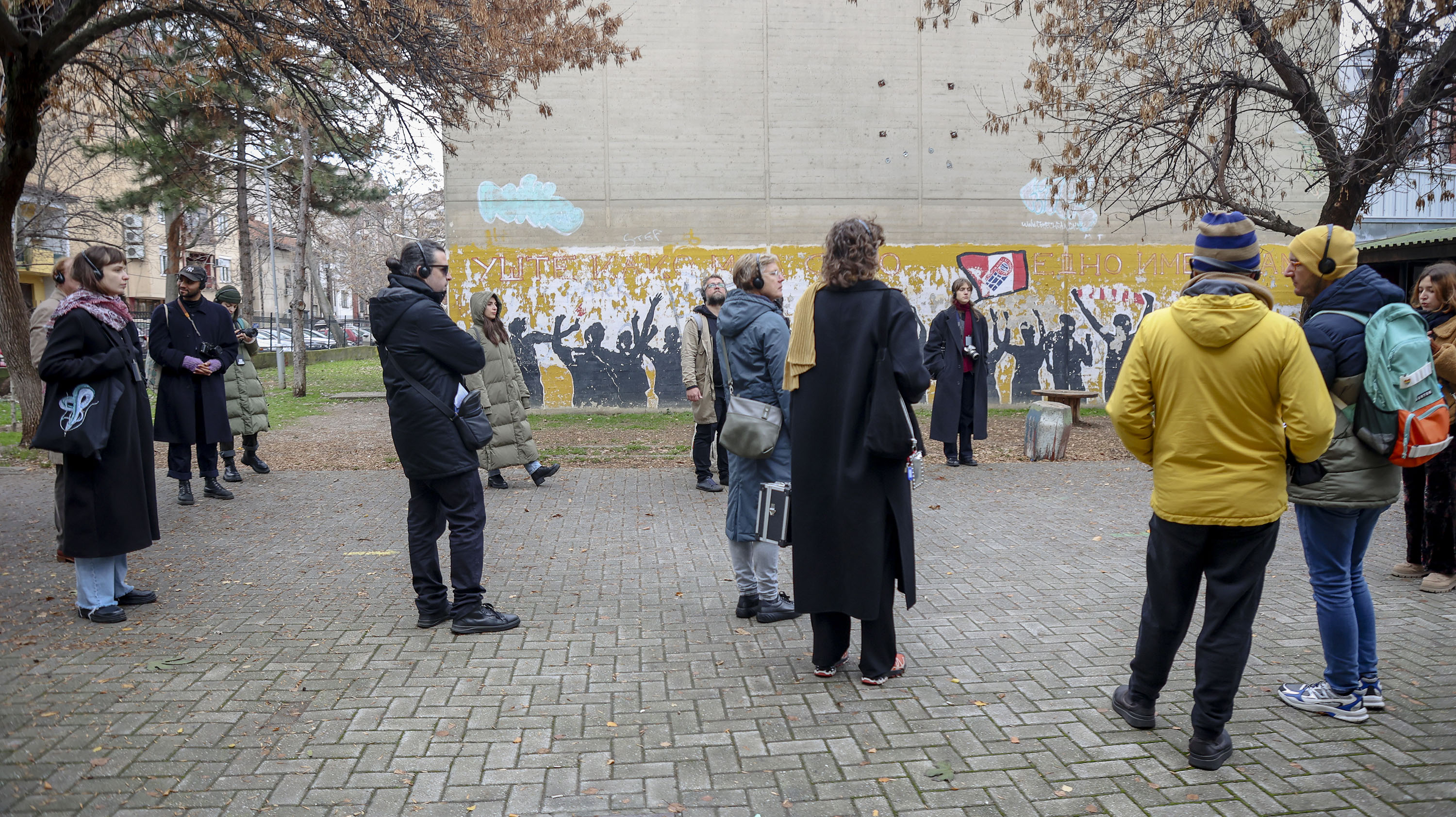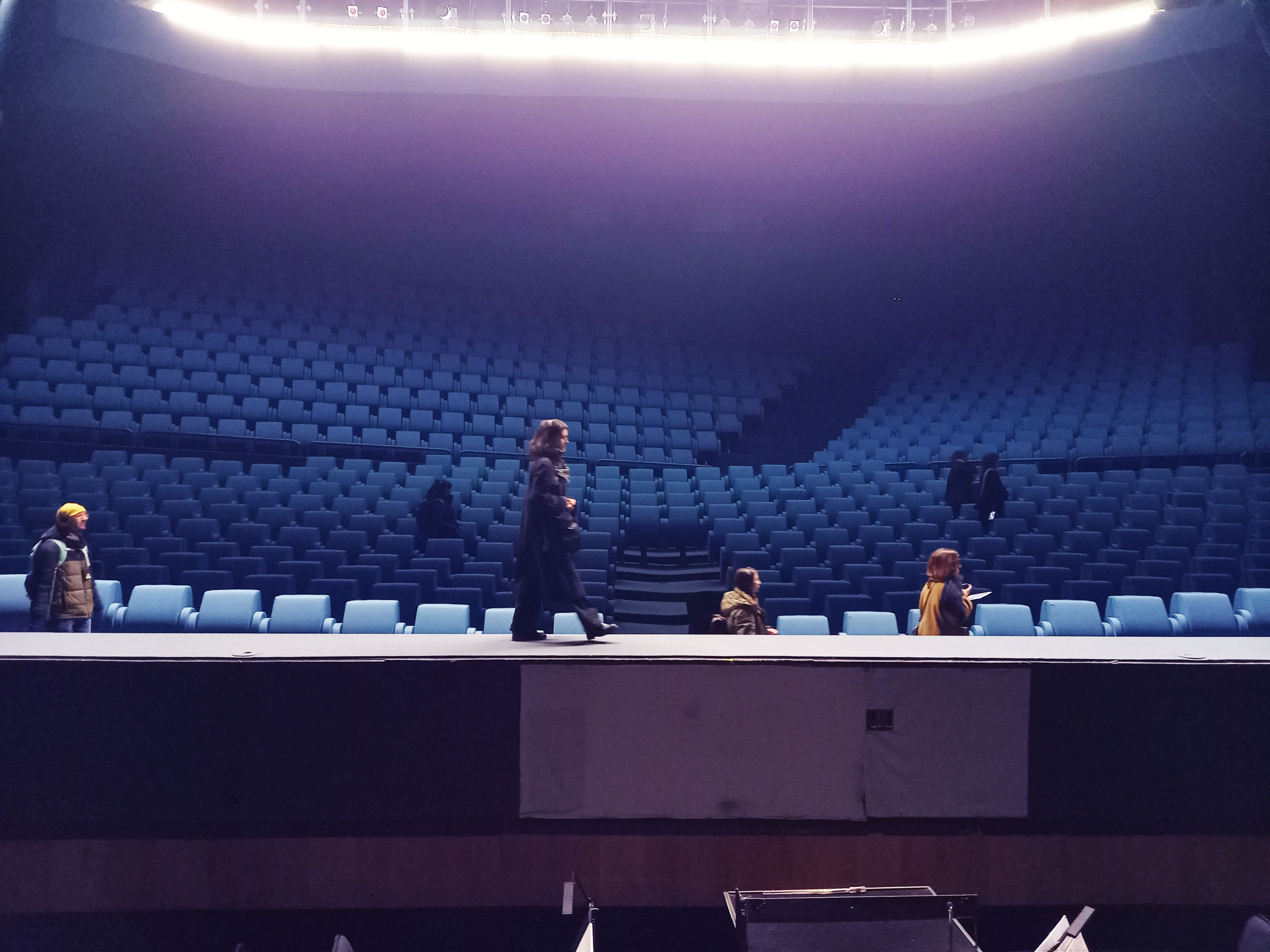Regaining a sense of belonging
City as a stage
City as a stage:Methodology of Reading Buildings
The Platform City as a Stage examines city spaces by engaging with people, taking notes, photographs, and videos, and debating with authorities. Through performative engagement with architectural heritage, it aims to learn from the modernist utopia and use it as a resource, extracting elements like solidarity and equality. By involving locals, it rethinks how transnational solidarity can reshape the city.
North Macedonia
Local
City of Skopje, Republic of North Macedonia
Mainly urban
It refers to other types of transformations (soft investment)
Yes
2024-12-07
Yes
European cultural foundation
project: If buildings could talk (2015)
project: Creative Europe
project: Islands of kinship(2022-2024)
project: Active city(zens) (2023-2024)
We don’t want to be stars (but parts of constellations(2023-2026)
No
No
As a representative of an organisation
The Platform City as a Stage examines city spaces by engaging with people, taking notes, photographs, and videos, and debating with authorities. Through performative engagement with architectural heritage, it aims to learn from the modernist utopia and use it as a resource, extracting elements like solidarity and equality. By involving locals, it rethinks how transnational solidarity can reshape the city.
The Method of Reading Buildings transforms a building (city) into a stage, using biographical analysis to rediscover layered histories and understand the present moment. It relies on artistic research methodologies, intertwining facts and fiction. This method critiques authoritative narratives and contributes alternative narratives, activating space through creating relations and bonds. It unites elements of architecture, stage design, visual and performing arts, advocating for the preservation of the public realm.
In the past decade, FRU focused on several buildings(public spaces) as stages:
Railway Residential Building (2015 – 2024)
Universal Hall (2020)
Macedonian Post Office (2021)
Domche Building (2021 – 2023)
The city is a public – performative (walking) essay(2024)
This project aims to encourage us as a collective to engage with the city as an open, public resource and learn from the traces of the abandoned solidarity. To excite and provoke positive experiences of engagement and involvement of the local community, especially young people, as well as local authorities, artists, intellectuals, experts, and the general public.
We believe all this is particularly important at a time when the idea of preserving the city is a strong imperative driven by an almost violent desire to build a new urban identity that threatens the urban habitat, not only in an ideological, but also in a physical sense, there is an urgent need to construct new mechanisms and methods that citizens will be able to absorb in order to protect themselves and face the situations
The Method of Reading Buildings transforms a building (city) into a stage, using biographical analysis to rediscover layered histories and understand the present moment. It relies on artistic research methodologies, intertwining facts and fiction. This method critiques authoritative narratives and contributes alternative narratives, activating space through creating relations and bonds. It unites elements of architecture, stage design, visual and performing arts, advocating for the preservation of the public realm.
In the past decade, FRU focused on several buildings(public spaces) as stages:
Railway Residential Building (2015 – 2024)
Universal Hall (2020)
Macedonian Post Office (2021)
Domche Building (2021 – 2023)
The city is a public – performative (walking) essay(2024)
This project aims to encourage us as a collective to engage with the city as an open, public resource and learn from the traces of the abandoned solidarity. To excite and provoke positive experiences of engagement and involvement of the local community, especially young people, as well as local authorities, artists, intellectuals, experts, and the general public.
We believe all this is particularly important at a time when the idea of preserving the city is a strong imperative driven by an almost violent desire to build a new urban identity that threatens the urban habitat, not only in an ideological, but also in a physical sense, there is an urgent need to construct new mechanisms and methods that citizens will be able to absorb in order to protect themselves and face the situations
architecture
performance
community
research
education
FRU’s long-term work in the field of contemporary art and culture, with a focus on research projects that actively involve different types of citizen communities and young people, opened different perspectives in the work process, as well as needs of the local cultural context and ways in which it can improve.
Such interdisciplinary work process (recognized both regionally and internationally) led us continue and research different case studies(building/stages), with the aim of improving the practical and theoretical skills of young people and wider cultural context, as well as the citizens and the local communities.
This approach was set in motion with the project "If Buildings Could Talk" (2014 - ) where the focus was the urban community in the cinema of the Railway Building (public space) in Skopje, a project that was presented in a form of performative installation, within the Prague Quadrennial of Performance Design an Space 2019, where it won the main prize, "Golden Triga".
According to the jury, the performative installation, was a multilayered collaborative work that brings together many forms of scenography: space, stage, exposition, memory, community and communication. It demonstrates how performance activates an exhibition space, how design instigates narrative and scenography becomes activism within and beyond political context.
In developing the project If Buildings Could Talk, where the focus was on the urban community/the Railway Residential Building and its residents, this interdisciplinary approach of merging together multiple media including architecture, activism, theatre, visual arts, film and advocacy for specific policies, we came to the conclusion that the broad approach to work incorporates different types of stakeholders from students to experts, citizens and local authorities, and that effect, as well as the need of the cultural context requires it to be continued and perfected as a method in the future, which happened.
Such interdisciplinary work process (recognized both regionally and internationally) led us continue and research different case studies(building/stages), with the aim of improving the practical and theoretical skills of young people and wider cultural context, as well as the citizens and the local communities.
This approach was set in motion with the project "If Buildings Could Talk" (2014 - ) where the focus was the urban community in the cinema of the Railway Building (public space) in Skopje, a project that was presented in a form of performative installation, within the Prague Quadrennial of Performance Design an Space 2019, where it won the main prize, "Golden Triga".
According to the jury, the performative installation, was a multilayered collaborative work that brings together many forms of scenography: space, stage, exposition, memory, community and communication. It demonstrates how performance activates an exhibition space, how design instigates narrative and scenography becomes activism within and beyond political context.
In developing the project If Buildings Could Talk, where the focus was on the urban community/the Railway Residential Building and its residents, this interdisciplinary approach of merging together multiple media including architecture, activism, theatre, visual arts, film and advocacy for specific policies, we came to the conclusion that the broad approach to work incorporates different types of stakeholders from students to experts, citizens and local authorities, and that effect, as well as the need of the cultural context requires it to be continued and perfected as a method in the future, which happened.
The method – reading buildings - develops itself by performing, i.e. it performs an active space (instead of the static posture of the building) as an aesthetic and ethical process of creating relations and bonds. Thus, the event emerging out of this specific method is a performance not as a physically built scenery, although it exists in a concrete building, but is an experiential and emotional modeling by an artistic process, forming and transformative, which wants to become a caring community that will act beyond its own threshold. It carries a contemporary cross-disciplinary engaged approach that unites elements of architecture, visual and performing arts and film, extending their scope and framing and advocates for the preservation of the meaning of the public in the midst of local urban problems, relating to a building or block (public or private) in a certain city.
This approach is transforming a building(city) in to a stage. Citizens are becoming an actors, architecture is becoming scenography, community problems are becoming text, theatre performance is transforming in to process of policy making
This method translates theatre-making protocols and builds upvarious artistic forms into urban context.Despite static posture of buildings, the method activates space through aesthetic and ethical processes of creating relations, whereas the main outcome is an event asexperiential and emotional artistic endeavour. In general, itpresents a cross-disciplinary approach that unites elements of architecture, visual and performing arts and film, extends their scopeand advocates meanings of the public and collective realm.
This approach is transforming a building(city) in to a stage. Citizens are becoming an actors, architecture is becoming scenography, community problems are becoming text, theatre performance is transforming in to process of policy making
This method translates theatre-making protocols and builds upvarious artistic forms into urban context.Despite static posture of buildings, the method activates space through aesthetic and ethical processes of creating relations, whereas the main outcome is an event asexperiential and emotional artistic endeavour. In general, itpresents a cross-disciplinary approach that unites elements of architecture, visual and performing arts and film, extends their scopeand advocates meanings of the public and collective realm.
This project aims to encourage us as a collective to engage with the city as an open, public resource and learn from the traces of the abandoned solidarity. To excite and provoke positive experiences of engagement and involvement of the local community, especially young people, as well as local authorities, artists, intellectuals, experts, and the general public. This project turns to the young generations of the local community and invites them to rethink the principles of solidarity using contemporary and creative tools for transforming the city.
Main, long-term goal of the project: With this project we envision creating a base of common knowledge and practices available to the general public through an art project, we want to open the space for the citizens, hear their voices and encourage creative interventions that will rethink the public spaces in the city.
The main goal is achievable only by setting several objectives:
• To establish an educational platform for interdisciplinary cooperation, which will create conditions for creating common knowledge, encourage and initiate active involvement of students, experts and the local community.
• To educate and include the students in a new interdisciplinary work approach that will encourage mechanisms on how to assert ther right to use the public space and the city within universal and democratic values.
• To empower the students and young creative people, as well as the wider circle of affected communities(and stakeholders – representatives of local municipalities and national institutions), in the possibility of creating cultural products that will contribute to the creation of a positive climate where spaces will express the voice of the citizen.
• To promote and share the results of the project, the knowledge from an interdisciplinary artistic practice that would explore different media and their interdisciplinary connection – visual arts, architecture, theater, video, film and special installations
Main, long-term goal of the project: With this project we envision creating a base of common knowledge and practices available to the general public through an art project, we want to open the space for the citizens, hear their voices and encourage creative interventions that will rethink the public spaces in the city.
The main goal is achievable only by setting several objectives:
• To establish an educational platform for interdisciplinary cooperation, which will create conditions for creating common knowledge, encourage and initiate active involvement of students, experts and the local community.
• To educate and include the students in a new interdisciplinary work approach that will encourage mechanisms on how to assert ther right to use the public space and the city within universal and democratic values.
• To empower the students and young creative people, as well as the wider circle of affected communities(and stakeholders – representatives of local municipalities and national institutions), in the possibility of creating cultural products that will contribute to the creation of a positive climate where spaces will express the voice of the citizen.
• To promote and share the results of the project, the knowledge from an interdisciplinary artistic practice that would explore different media and their interdisciplinary connection – visual arts, architecture, theater, video, film and special installations
The working methodology of this project is based on the active role and communication with local communities, sharing knowledge on equal level with other experts(architects, artists, curators) in terms of co-creating and involving in the process of programming the locals(citizens). In that sense, in the methodlogy of work we quote the second point of the film collective Dziga Vertov (Jean-Luc Godard/Jean Pierre Gorin) manifesto(1970) ‘What is to be done?
„We must make political films.We must make films politically".
Symbolically this quote means that citizens are direct(not representative) part of the methodology of work
In this direction, тhe project contributes to achieving the following results:
• Activating the citizens, local and expert communities by interaction of societal and urban problems and work together towards revitalization and/or re-interpretation of shared urban spaces in the city.
• Increased knowledge of actively involved students from of Architecture and Drama Arts in a new interdisciplinary research methodology, contemporary and innovative approaches in the production of contemporary art and culture and in the right to use and transform public space through working meetings/lectures/workshops.
• Producng participative cultural products/interventions in public space and interdisciplinary performances that contribute to the creation of a positive climate that allows space to express the citizen's voice and contextualize public spaces with all their historical and urban narratives and re-discover their meaning through productive research and innovative artistic practices.
• Increased visibility and support of the project idea by the local community and creation of a critical mass through the production of interventions in public space promoted through promotional online campaign on the activities and values of the project. Widen the circle of audience that will be informed about the city's problems, and new artistic approaches.
„We must make political films.We must make films politically".
Symbolically this quote means that citizens are direct(not representative) part of the methodology of work
In this direction, тhe project contributes to achieving the following results:
• Activating the citizens, local and expert communities by interaction of societal and urban problems and work together towards revitalization and/or re-interpretation of shared urban spaces in the city.
• Increased knowledge of actively involved students from of Architecture and Drama Arts in a new interdisciplinary research methodology, contemporary and innovative approaches in the production of contemporary art and culture and in the right to use and transform public space through working meetings/lectures/workshops.
• Producng participative cultural products/interventions in public space and interdisciplinary performances that contribute to the creation of a positive climate that allows space to express the citizen's voice and contextualize public spaces with all their historical and urban narratives and re-discover their meaning through productive research and innovative artistic practices.
• Increased visibility and support of the project idea by the local community and creation of a critical mass through the production of interventions in public space promoted through promotional online campaign on the activities and values of the project. Widen the circle of audience that will be informed about the city's problems, and new artistic approaches.
From the beginning of the developing of the methodology of reading buildings and taking actions on concrete buildings/public spaces, there was direct and indirect co-relation/collaboration with different stakeholders.
• If buildings could talk - regional project (Skopje-Zagreb-Belgrade, 2015), was funded by Balkans Arts and Culture
• Premiere site-specific performance on 42 international theater festival MOT in Skopje(2017).
• Signing agreement in public (on location) with the major of the municipality of Center in Skopje, for the future reconstruction of the cinema (2019).
• PQ(2019) where we won main prize, Golden Triga.
• We produced performative interventions around the case study of local community brutalist buidling called DOMCE (2021-2023).
Partners:
• ZK/U-Berlin(Center for Art and Urbanistics) supported by Goethe institute in Skopje.
• Architectural faculty in the frames of the project writing urban places:
COST Action 18126 Writing Urban Places,New Narratives of the European City
Skopje Brutalism Trail.
• Methodology was published in REPOSITORY: 49 METHODS AND ASSIGNMENTS FOR WRITING URBAN PLACES, CarlosMachado e Moura, DaliaMiliánBernal, EstebanRestrepoRestrepo, KlaskeHavik, LorinNiculae (eds.), (nai010 publishers, COST Action,2023), page. 119https://writingurbanplaces.eu/repository-49-methods-and.../
• Premiere of the performance City as a stage: lost modernistic utopias, at 47 International theater festival MOT in Skopje(2022)
• Grant from Creative Europe program, "Active city(zens)" (2023-2024), project leader: Prague Quadrennial (PQ), partners:, ZK/U-Berlin , "IZOLATSIA" – Kyiv.
• City as a stage: performing public spaces(2023-2024), we continue collaboration on this methodology of reading buildings, supported by The Cultural Program of the Swiss Embassy in the Republic of North Macedonia, GETE Institute Skopje, Ministry of Culture of the Republic of North Macedonia.
• If buildings could talk - regional project (Skopje-Zagreb-Belgrade, 2015), was funded by Balkans Arts and Culture
• Premiere site-specific performance on 42 international theater festival MOT in Skopje(2017).
• Signing agreement in public (on location) with the major of the municipality of Center in Skopje, for the future reconstruction of the cinema (2019).
• PQ(2019) where we won main prize, Golden Triga.
• We produced performative interventions around the case study of local community brutalist buidling called DOMCE (2021-2023).
Partners:
• ZK/U-Berlin(Center for Art and Urbanistics) supported by Goethe institute in Skopje.
• Architectural faculty in the frames of the project writing urban places:
COST Action 18126 Writing Urban Places,New Narratives of the European City
Skopje Brutalism Trail.
• Methodology was published in REPOSITORY: 49 METHODS AND ASSIGNMENTS FOR WRITING URBAN PLACES, CarlosMachado e Moura, DaliaMiliánBernal, EstebanRestrepoRestrepo, KlaskeHavik, LorinNiculae (eds.), (nai010 publishers, COST Action,2023), page. 119https://writingurbanplaces.eu/repository-49-methods-and.../
• Premiere of the performance City as a stage: lost modernistic utopias, at 47 International theater festival MOT in Skopje(2022)
• Grant from Creative Europe program, "Active city(zens)" (2023-2024), project leader: Prague Quadrennial (PQ), partners:, ZK/U-Berlin , "IZOLATSIA" – Kyiv.
• City as a stage: performing public spaces(2023-2024), we continue collaboration on this methodology of reading buildings, supported by The Cultural Program of the Swiss Embassy in the Republic of North Macedonia, GETE Institute Skopje, Ministry of Culture of the Republic of North Macedonia.
The title of the project tried to put in active relation the term city and its performers (citizens) - participants in creating (transforming) their (urban) surrounding (into performative space).
Using an interdisciplinary research approach, architecture students and students of dramatic and performing arts, experts, citizens, artists, researchers, it instigates prototypes for performances in public space that transform the city into a stage. These prototypes represent tools, instructions and recommendations on how rare experiences of a city can create the possibility of a new, extraordinary, radical reality as a process for building better future.
The project intends to develop innovative audience building approaches that support community engagement while at the same time preserve local cultural values and develop methods of cross-cultural programming. The wide range of interventions into public spaces include areas with limited cultural reach,, abandoned (heritage) sites and many more.
The general idea aims to develop prototypes for interventions that will exhaust the full potential of the city as an invisible resource. By creating new prototypes of culture programming, performative activities and interventions it will give an opportunity to redirect some of the attention the public is currently giving to advertising and commerce in order to rediscover unique public spaces and create new forms of vibrant short performance bites.
The project also relies on contemporary artistic performative and urban research practices close to the field of scene design, extending the field of scenography and its wider role in the society. One of the major challenges was how to utilize the performative (scene) tools to transform the non-places within the urban context in order to create performative (active) and engaged space (place) ready to grasp and embrace any action.
Using an interdisciplinary research approach, architecture students and students of dramatic and performing arts, experts, citizens, artists, researchers, it instigates prototypes for performances in public space that transform the city into a stage. These prototypes represent tools, instructions and recommendations on how rare experiences of a city can create the possibility of a new, extraordinary, radical reality as a process for building better future.
The project intends to develop innovative audience building approaches that support community engagement while at the same time preserve local cultural values and develop methods of cross-cultural programming. The wide range of interventions into public spaces include areas with limited cultural reach,, abandoned (heritage) sites and many more.
The general idea aims to develop prototypes for interventions that will exhaust the full potential of the city as an invisible resource. By creating new prototypes of culture programming, performative activities and interventions it will give an opportunity to redirect some of the attention the public is currently giving to advertising and commerce in order to rediscover unique public spaces and create new forms of vibrant short performance bites.
The project also relies on contemporary artistic performative and urban research practices close to the field of scene design, extending the field of scenography and its wider role in the society. One of the major challenges was how to utilize the performative (scene) tools to transform the non-places within the urban context in order to create performative (active) and engaged space (place) ready to grasp and embrace any action.
• Activating lack of critical thinking amoung young but also ordinary citizens/constituents
• Activating lack of participation of citizens.
• А unique knowledge(based on a methodlogy), will be created that can be used in the future for public interests as an example to be followed.
• Combination of formal and informal education
• Involving experts from academia but also civil sector. cultural workers, activist, curators.
• Our approach consistently sought to blur the line between audience and performer, between citizens and experts.
• If we were to summarize the methodology for activating the audience, it could be distilled into several key concepts:
CLOSE WORK with the COMMUNITY (experts - students - cityzens) – RESEARCH – PRODUCTION .
• In the research wе involve from local citizens, experts, students, artists, curators, activists, participants in events, journalists etc.
• Exploring the mechanism of non-democracy, instead of the classic 'taking' aside and increasing the knowledge and skills to recognize what is the public interest is something that until now in our context has not been addressed in this way.
• Create a tool kit(precied methodology) for an open resource platform that will involve and articulate future citizens problems/ideas/needs.
• The need for public space as an important element in a democratic society;
• Adressing Lack of youth involvement in interdisciplinary research projects that will make a connection between culture/art and social problems.
• Almost complete ignorance of the potential of culture and art in raising awareness and visibility of social problems.
• To learn from the traces of the already forgotten social narratives and values that it holds, through the engagement and inclusion of different communities and local authorities, as well as a range of artists, intellectuals, and experts who work in the field of culture and art in our country.
• Activating lack of participation of citizens.
• А unique knowledge(based on a methodlogy), will be created that can be used in the future for public interests as an example to be followed.
• Combination of formal and informal education
• Involving experts from academia but also civil sector. cultural workers, activist, curators.
• Our approach consistently sought to blur the line between audience and performer, between citizens and experts.
• If we were to summarize the methodology for activating the audience, it could be distilled into several key concepts:
CLOSE WORK with the COMMUNITY (experts - students - cityzens) – RESEARCH – PRODUCTION .
• In the research wе involve from local citizens, experts, students, artists, curators, activists, participants in events, journalists etc.
• Exploring the mechanism of non-democracy, instead of the classic 'taking' aside and increasing the knowledge and skills to recognize what is the public interest is something that until now in our context has not been addressed in this way.
• Create a tool kit(precied methodology) for an open resource platform that will involve and articulate future citizens problems/ideas/needs.
• The need for public space as an important element in a democratic society;
• Adressing Lack of youth involvement in interdisciplinary research projects that will make a connection between culture/art and social problems.
• Almost complete ignorance of the potential of culture and art in raising awareness and visibility of social problems.
• To learn from the traces of the already forgotten social narratives and values that it holds, through the engagement and inclusion of different communities and local authorities, as well as a range of artists, intellectuals, and experts who work in the field of culture and art in our country.
The approach of work in this project is based on the idea of applying in-depth genealogical research and innovative artistic practices with the idea of recontextualizing public spaces with all their historical, cultural and urban narratives and thereby re-learning their often forgotten symbolic and material meaning and importance.
The work within this project will aim to highlight the right to use public space or the public sphere as universal and democratic values.
The artistic-curatorialduoFilip Jovanovski and Ivana Vasevaintroduce this method on several occasions in different projects and performances over the last decade, shedding light onparticularbuildingswith historical and political relevance. They explore the influence ofneoliberal reality onpost-socialist societiesfound in the pervasive changes of local socio-spatial context, andcallfor urgent construction ofnew mechanisms and methods that citizens can appropriatein order tocoop with rapid change inbuild environment and everyday life.
The method is based on an analogy with typical theater-making protocols consisting of five steps: 1-choosing a text/drama, 2-dramatic reading with actors at a table,3-text adaptation for specific stage and audience, 4-rehearsals on stage with actors and 5-final outcome, the premiere.In this specific method, that protocol is transformed into urban context, addressing a particular building.
The work within this project will aim to highlight the right to use public space or the public sphere as universal and democratic values.
The artistic-curatorialduoFilip Jovanovski and Ivana Vasevaintroduce this method on several occasions in different projects and performances over the last decade, shedding light onparticularbuildingswith historical and political relevance. They explore the influence ofneoliberal reality onpost-socialist societiesfound in the pervasive changes of local socio-spatial context, andcallfor urgent construction ofnew mechanisms and methods that citizens can appropriatein order tocoop with rapid change inbuild environment and everyday life.
The method is based on an analogy with typical theater-making protocols consisting of five steps: 1-choosing a text/drama, 2-dramatic reading with actors at a table,3-text adaptation for specific stage and audience, 4-rehearsals on stage with actors and 5-final outcome, the premiere.In this specific method, that protocol is transformed into urban context, addressing a particular building.
The methodology of reading buildings can be for sure transferred in other city/cultural context. Following a very precise steps for reading buildings(public spaces) in a certain city, it can be easily re-contextualise.
In the first two steps of theatre protocols a building is taken as a text to be investigated. It starts with selection of a building that bears social, historical and architectural relevance in a given contextand collecting relevant information material about it.Besides consulting professionals and official institutions, it greatly depends on the personal viewpoint(s), memories and stories, which requiresclose cooperation with local community.
The third and the fourth stepsare fundamentally creative act where collected data and informational material are transferred in new narratives. The specific combination of facts and fiction, narration and acting in a direct form of communication has the aim to drag the audience into a walk through the historical synchronicities creating building’s emotional chronicle. For example, in the performance ‘This building talks (truly)’ that narrates building’s biography throughlife episodes of its residents, verified andmade-up stories are interweaving: one out of three stories are fictional, such as the one aboutarchitect Bogdanović staying in the building(fiction)shortlyafter fleeingthe political regime in neighboring country and before reaching his final destination(true),which is quite possible since he was for sure in Skopje in that period.
The final step- the ‘premiere’,is public on-site event, an interactive performance where actors, space and audience actively co-participate. Producing such perfromative event is largely based on participative collaboration with local communities, which transforms the artistic approach from acting into a tool of advocating.
In the first two steps of theatre protocols a building is taken as a text to be investigated. It starts with selection of a building that bears social, historical and architectural relevance in a given contextand collecting relevant information material about it.Besides consulting professionals and official institutions, it greatly depends on the personal viewpoint(s), memories and stories, which requiresclose cooperation with local community.
The third and the fourth stepsare fundamentally creative act where collected data and informational material are transferred in new narratives. The specific combination of facts and fiction, narration and acting in a direct form of communication has the aim to drag the audience into a walk through the historical synchronicities creating building’s emotional chronicle. For example, in the performance ‘This building talks (truly)’ that narrates building’s biography throughlife episodes of its residents, verified andmade-up stories are interweaving: one out of three stories are fictional, such as the one aboutarchitect Bogdanović staying in the building(fiction)shortlyafter fleeingthe political regime in neighboring country and before reaching his final destination(true),which is quite possible since he was for sure in Skopje in that period.
The final step- the ‘premiere’,is public on-site event, an interactive performance where actors, space and audience actively co-participate. Producing such perfromative event is largely based on participative collaboration with local communities, which transforms the artistic approach from acting into a tool of advocating.
We will metione some of the global(but also local) chalengs that we are facing:
• The public sphere remained polarized and destroyed as a precondition for conversation, dialogue, space for exchange of opinions that would lead us to a society that would defend public interests, as opposed to party or private, which is often the case in the global and local context.
• Has this society learned the mechanisms of (un)democracy that are in danger of recurring in a much more terrible form in the future?
• What is left of the solidarity and what is the power of the citizen to use (build and create) the city, according to the universal democratic values of a contemporary society?
• What are the opportunities, for young people in particular to participate in educational and production processes that will enable them to be more involved in contemporary social trends, with a focus on using tools from art and culture(that will oppose to the current dominant neoliberal, market conditions)?
The answers to he questions are the major shortcomings that this project is addressing through several approaches:
• This project is focused on the citizen's voice, which is the basis of building the content of the project, as well as the citizen‘s right to use public space or the public sphere as universal and democratic values.
• Collaboration with citizens and sharing their opinion and collaboration with young people/students, makes this project a place for exchanging views, for the collective struggle to preserve the public and archive their needs through a new platform for exchange – the art projects and educational activities.
• Participation, inclusion and creation of common knowledge that will complement the formal knowledge from the faculties, promotion of an interdisciplinary approach to work, which is not sufficiently promoted in our cultural context as an artistic practice, are the topics that should respond to the current context through this project.
• The public sphere remained polarized and destroyed as a precondition for conversation, dialogue, space for exchange of opinions that would lead us to a society that would defend public interests, as opposed to party or private, which is often the case in the global and local context.
• Has this society learned the mechanisms of (un)democracy that are in danger of recurring in a much more terrible form in the future?
• What is left of the solidarity and what is the power of the citizen to use (build and create) the city, according to the universal democratic values of a contemporary society?
• What are the opportunities, for young people in particular to participate in educational and production processes that will enable them to be more involved in contemporary social trends, with a focus on using tools from art and culture(that will oppose to the current dominant neoliberal, market conditions)?
The answers to he questions are the major shortcomings that this project is addressing through several approaches:
• This project is focused on the citizen's voice, which is the basis of building the content of the project, as well as the citizen‘s right to use public space or the public sphere as universal and democratic values.
• Collaboration with citizens and sharing their opinion and collaboration with young people/students, makes this project a place for exchanging views, for the collective struggle to preserve the public and archive their needs through a new platform for exchange – the art projects and educational activities.
• Participation, inclusion and creation of common knowledge that will complement the formal knowledge from the faculties, promotion of an interdisciplinary approach to work, which is not sufficiently promoted in our cultural context as an artistic practice, are the topics that should respond to the current context through this project.
Using the methodology of reading buildings, FRU produced performances and interventions in public spaces. So far created around ten performative interventions in public space, local and international educational workshops, publications, international exhibitions and performances, lectures, etc.
Significant case studies include the Railway Residential Building and the Domche building, both important for their community, historical, societal, architectural, and civic significance.
After FRU’s initiative, a proposal for protecting Domche as cultural heritage was sent to the national institution, though the process is ongoing due to administrative issues. For the Railway Building, despite signing an agreement with municipality of Center in Skopje, for reconstruction in 2019, progress stalled. FRU plans to start an international crowdfunding campaign for reconstruction in 2025. The relations between FR~U team and the local community(residents) in the bulding are on a high level, so in the next step there is an interest from the bulding community to co-govern this space with FRU and wider civil society sector.
The continuation of the project in the past decade(2015 – 2024 ) initiated an informal community of artists, experts, collaborators, curators, students and wider public. In that direction, FR~U initiated a new educational platform named: Laboratory for Performative Space Practices: City as a Stage The laboratory as an informal educational platform, is spatially located at the Faculty of Architecture in Skopje, as a partner of the project.
This interdisciplinary platform focuses on researching, understanding, and creating contemporary public space through experimental, processual, and collaborative approaches.
The approach involves mentoring and research work with students, including workshops, lectures, and active involvement of citizens. The goal is to create prototypes for understanding and intervening in public space through a defined methodology.
Significant case studies include the Railway Residential Building and the Domche building, both important for their community, historical, societal, architectural, and civic significance.
After FRU’s initiative, a proposal for protecting Domche as cultural heritage was sent to the national institution, though the process is ongoing due to administrative issues. For the Railway Building, despite signing an agreement with municipality of Center in Skopje, for reconstruction in 2019, progress stalled. FRU plans to start an international crowdfunding campaign for reconstruction in 2025. The relations between FR~U team and the local community(residents) in the bulding are on a high level, so in the next step there is an interest from the bulding community to co-govern this space with FRU and wider civil society sector.
The continuation of the project in the past decade(2015 – 2024 ) initiated an informal community of artists, experts, collaborators, curators, students and wider public. In that direction, FR~U initiated a new educational platform named: Laboratory for Performative Space Practices: City as a Stage The laboratory as an informal educational platform, is spatially located at the Faculty of Architecture in Skopje, as a partner of the project.
This interdisciplinary platform focuses on researching, understanding, and creating contemporary public space through experimental, processual, and collaborative approaches.
The approach involves mentoring and research work with students, including workshops, lectures, and active involvement of citizens. The goal is to create prototypes for understanding and intervening in public space through a defined methodology.

